I’ll keep the words to a minimum because this is a picture heavy post. I’m sharing some of the houses that caught my eye in the Garden District.
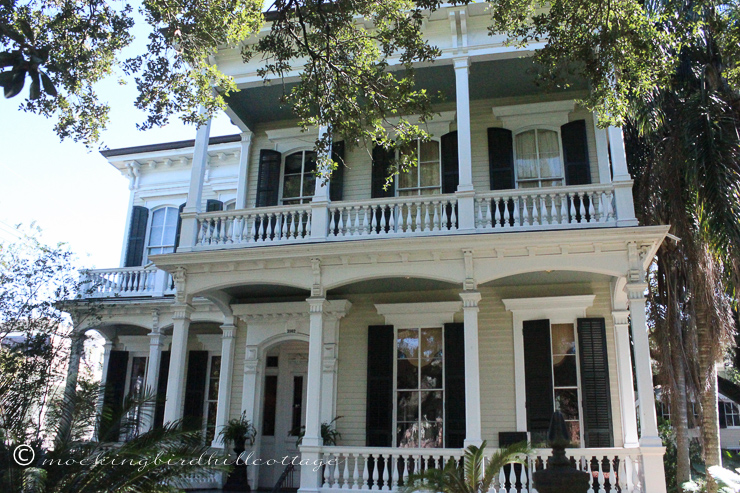
One of the larger homes. Beautiful.
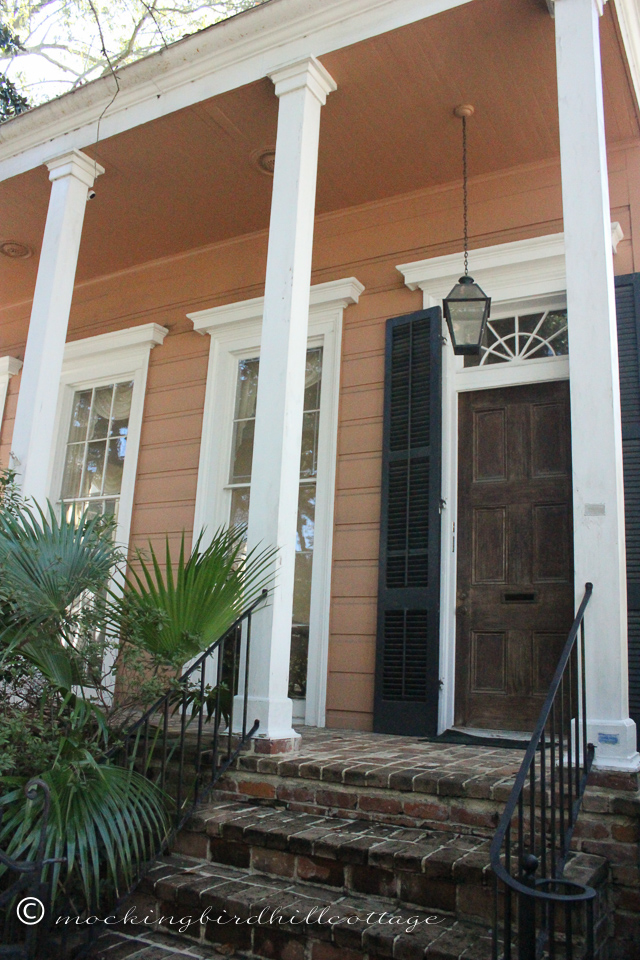
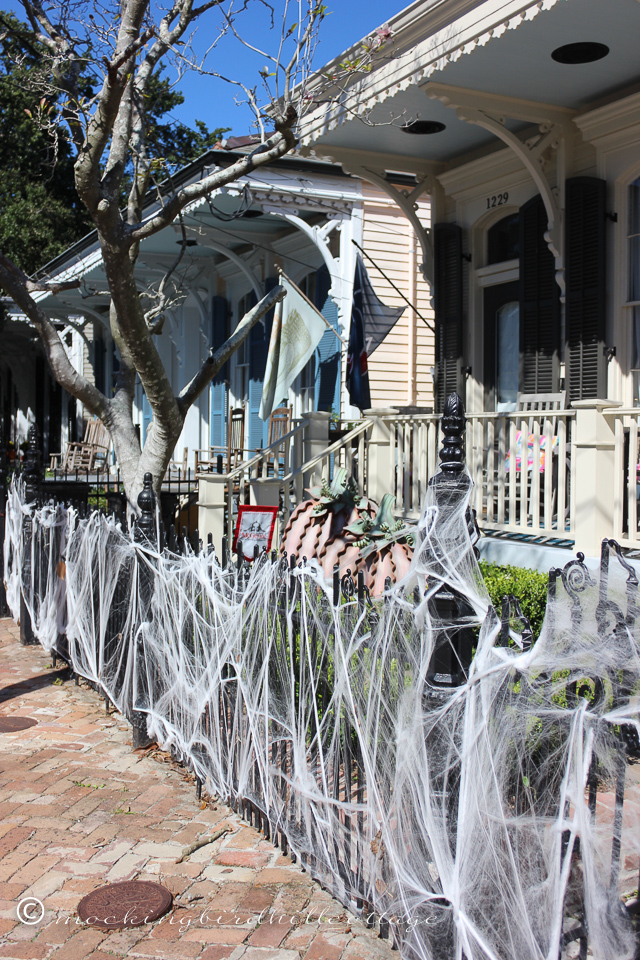
Most houses are decorated for Halloween.
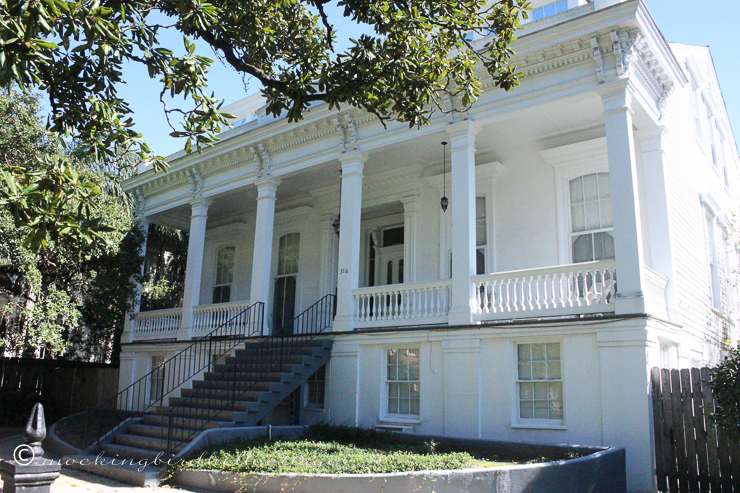
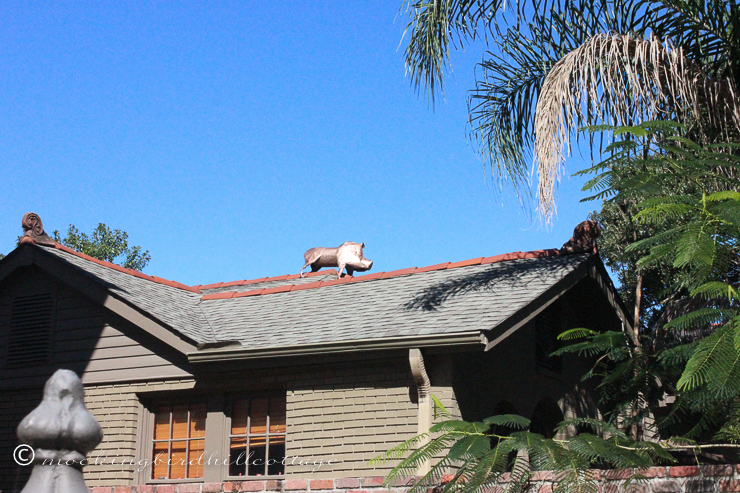
Interesting roof ornament, don’t you think?
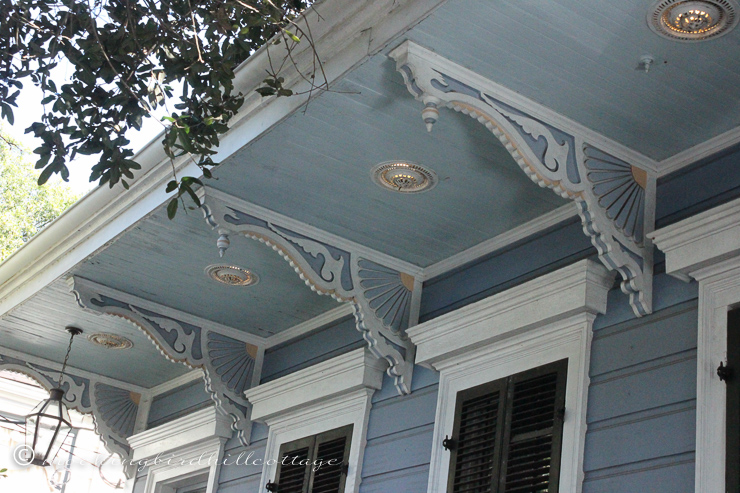
These details make my heart beat faster. So lovely.
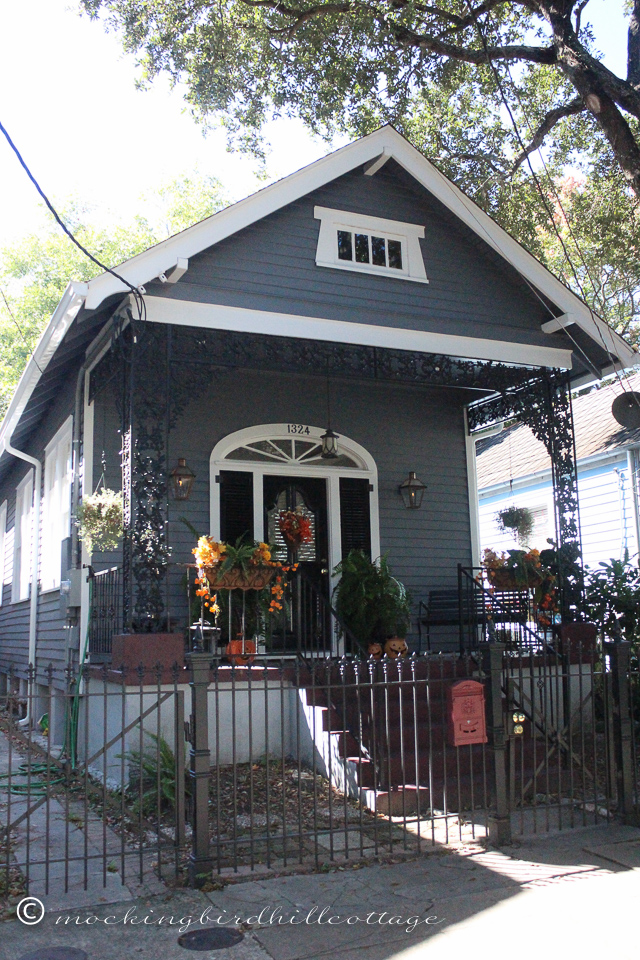
I’m especially drawn to the smaller houses.
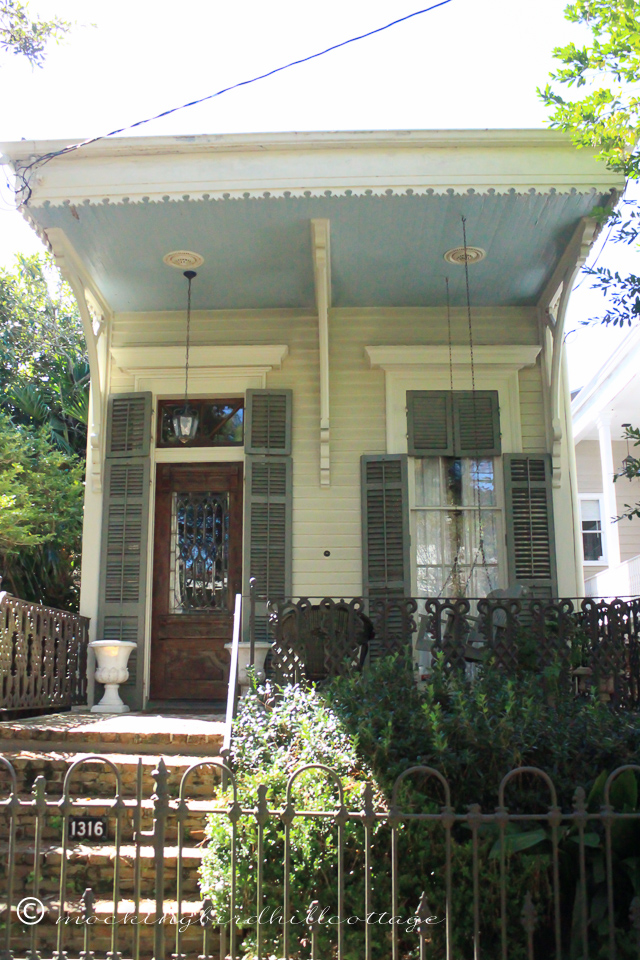
Just stop. Look at this place! Could it be any more charming? Blue ceiling. Gorgeous front door. And I’m particularly taken by the shutters that are in sections, allowing light in at the top yet still providing privacy. Or, in this case, shutting the top section and opening the lower sections of the shutters.
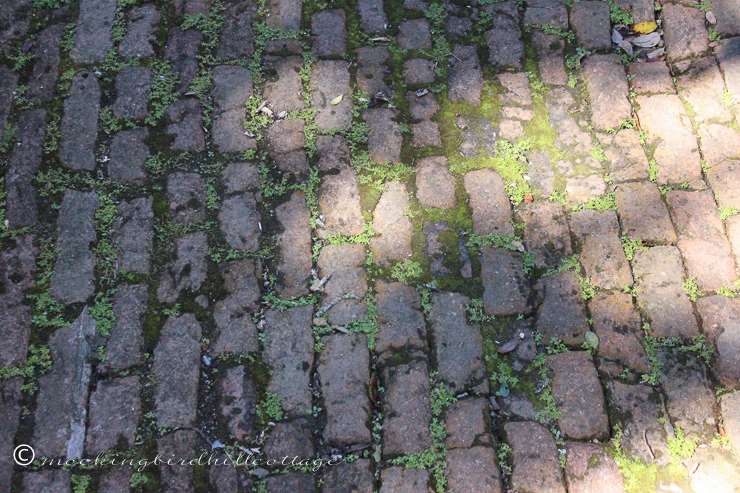
Sidewalks are brick.
Trees are large and the roots often pull up portions of the sidewalks. Walking requires constant vigilance!
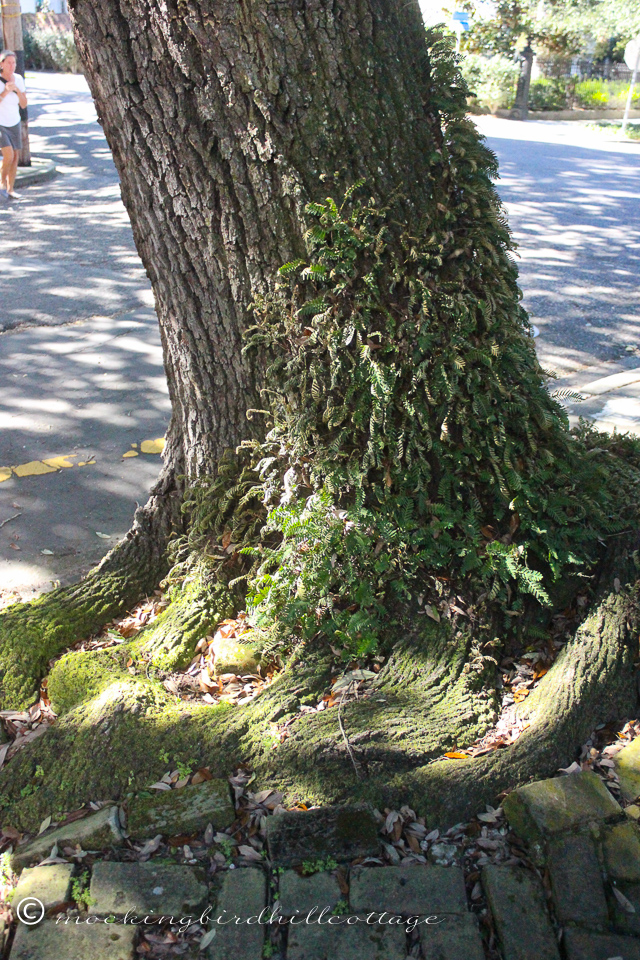
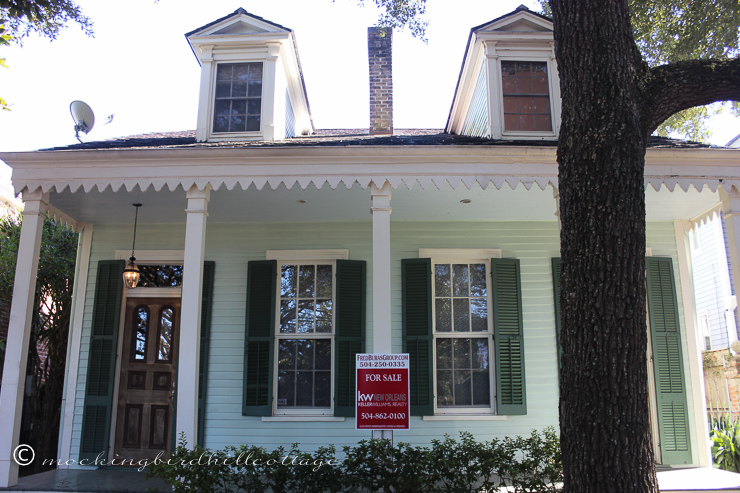
This one’s for sale. Any takers? The doors – though you can’t tell from this photo – are gorgeous.
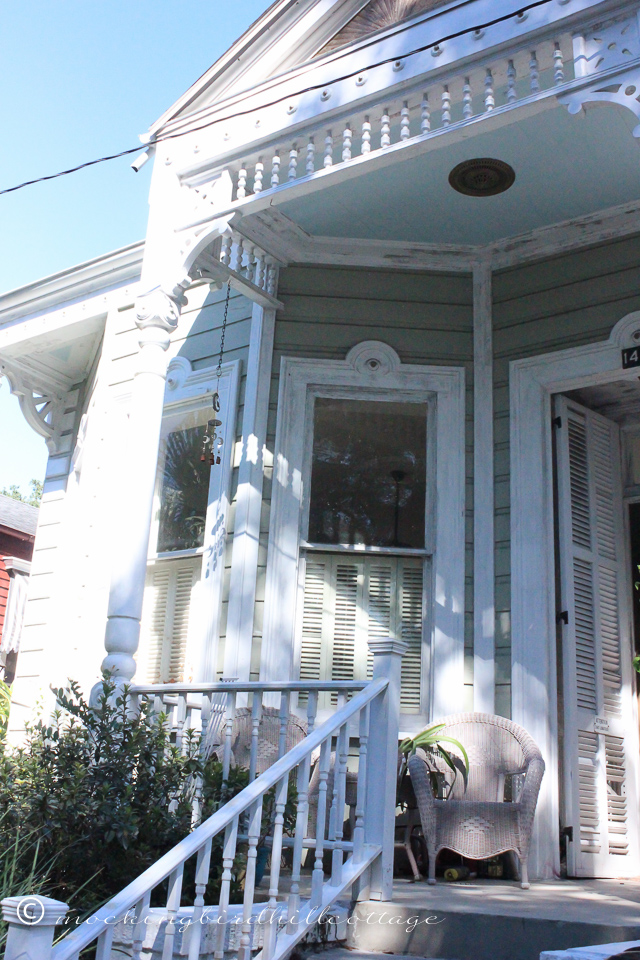
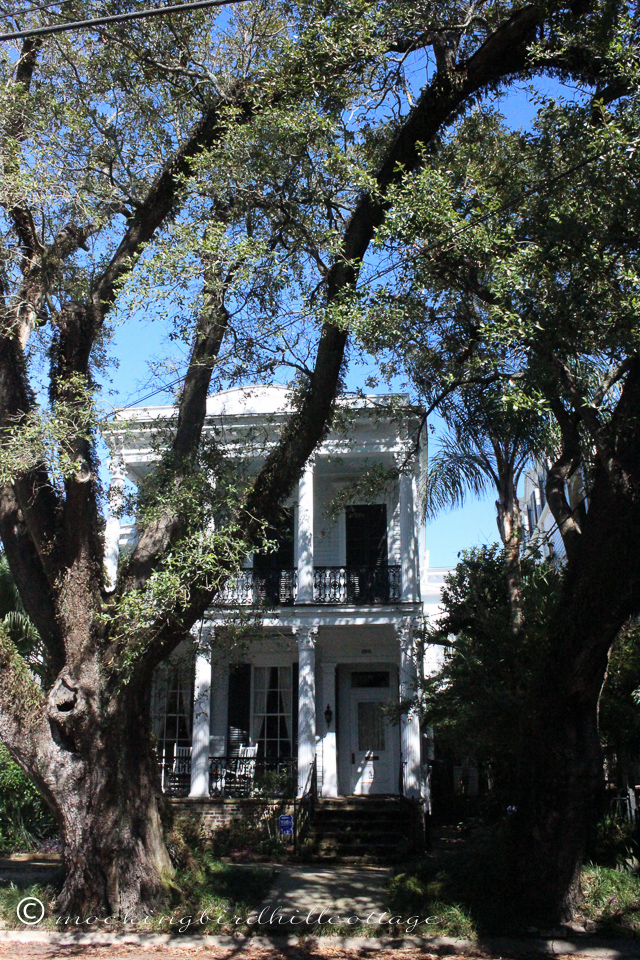
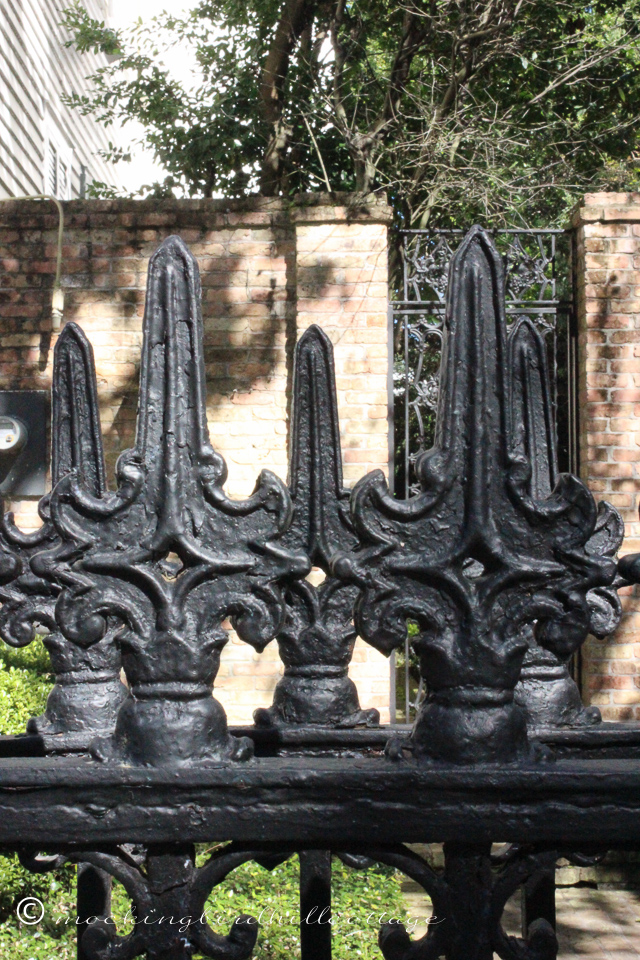
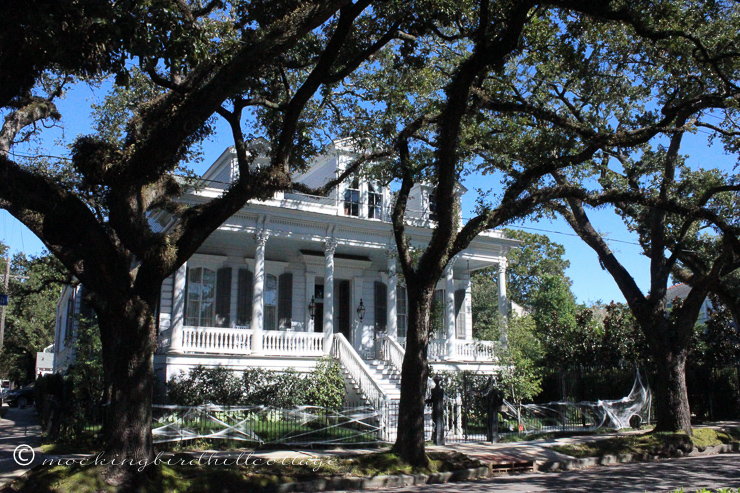
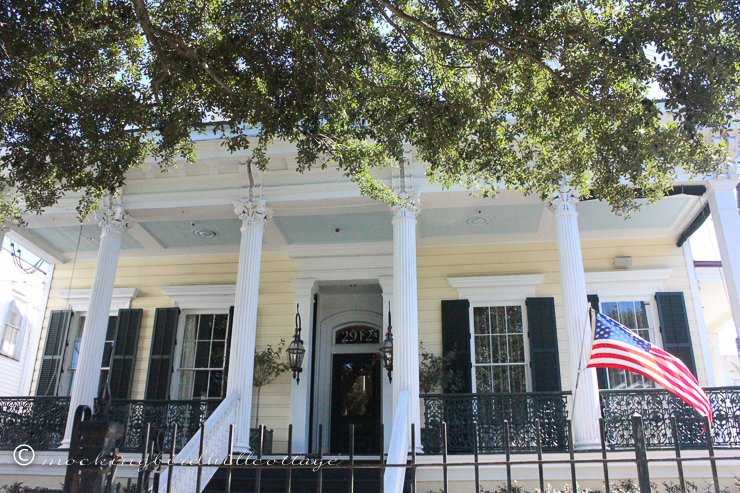
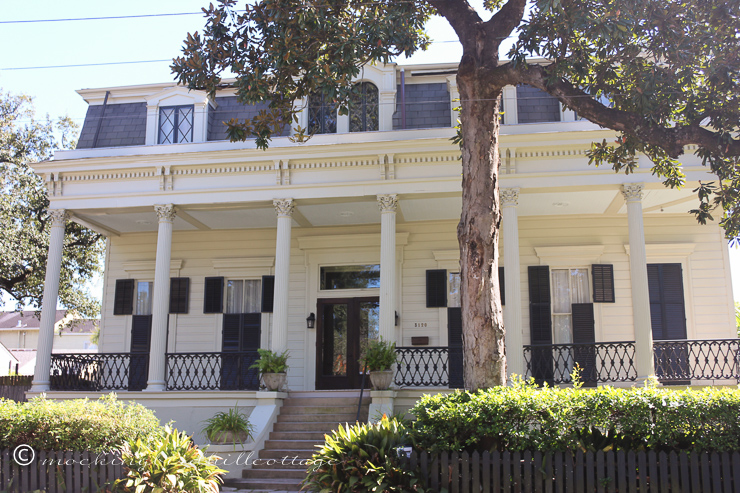
These shutters are opened/closed in interesting combinations.
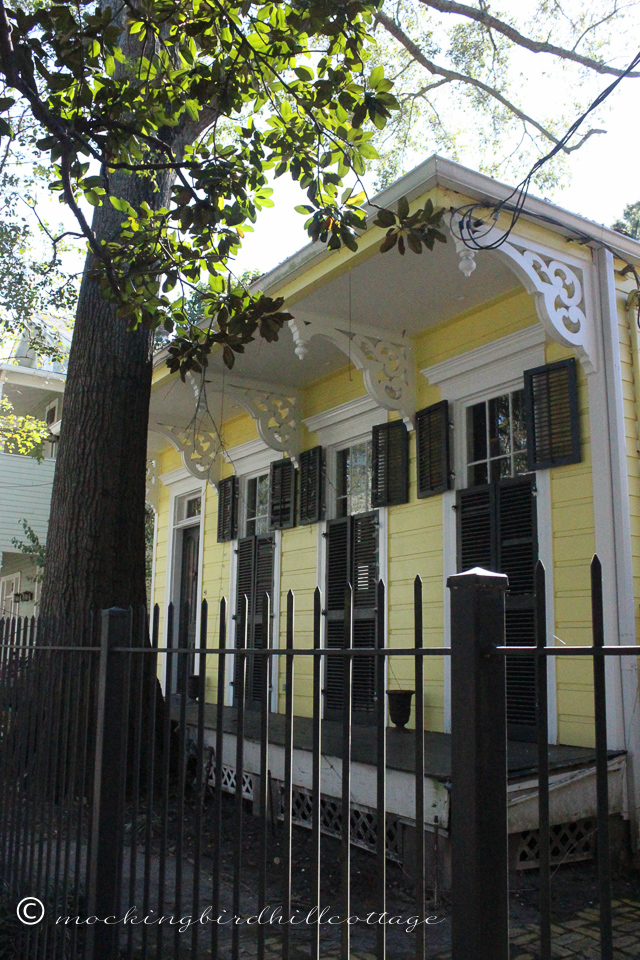
These are opened at the top.
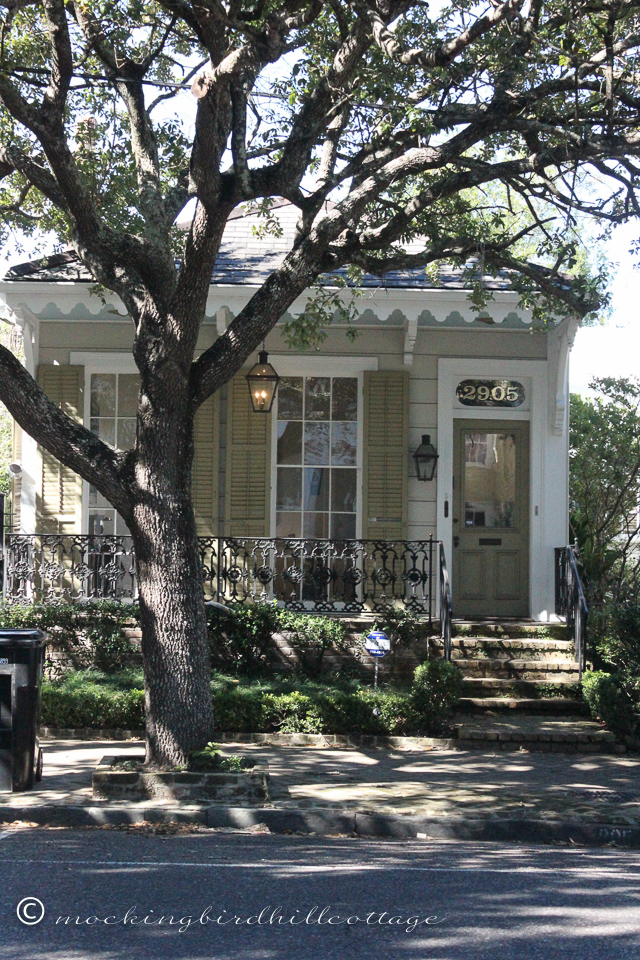
Oh my heavens.
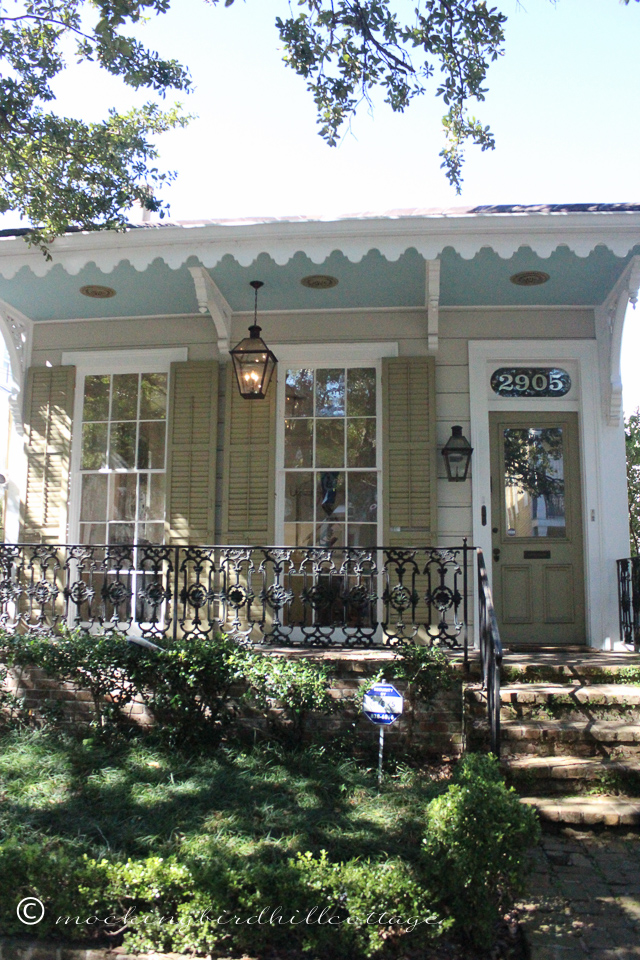
Check out that ceiling. Isn’t this house adorable?
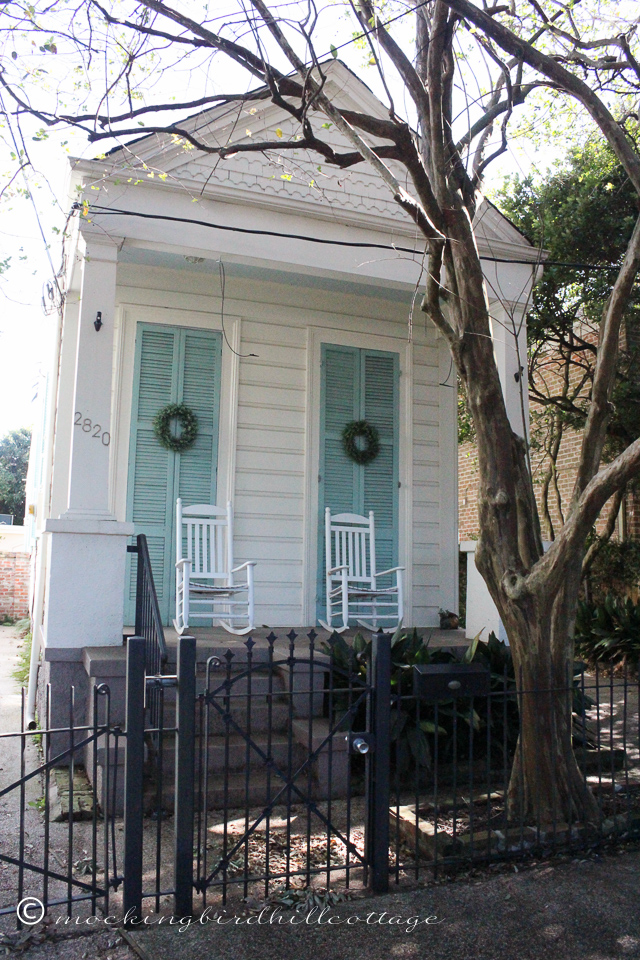
I love this one. The houses that tend to be narrow usually extend far back as this one does.
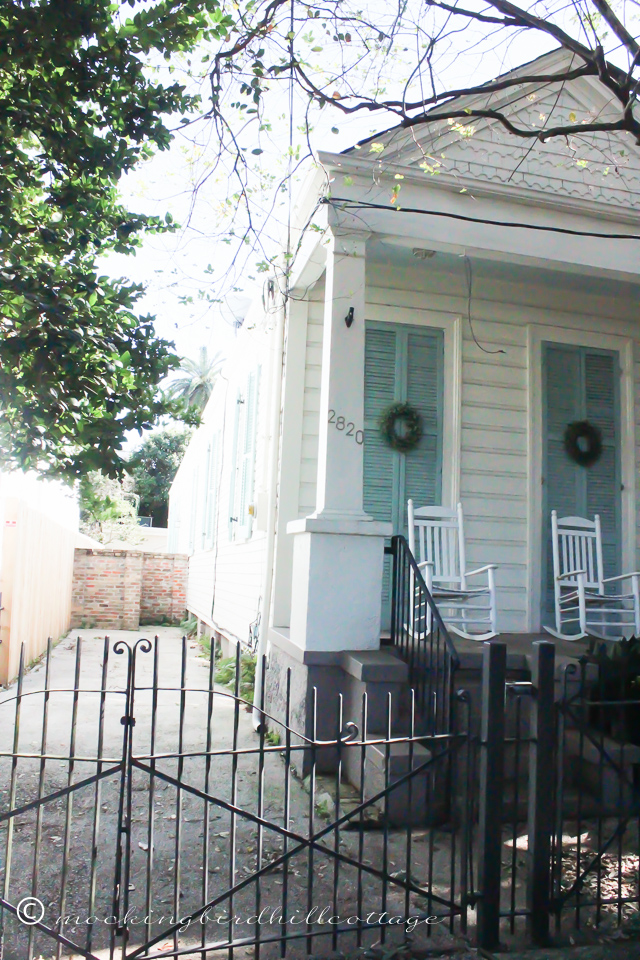
See? It goes way back and has a private garden behind the brick wall.
The blue shutters, the wreaths, and the white rockers. Sigh.
There are so many more but I had to stop. The streets are tree lined and charming. I ran into several dog walkers and had some lovely chats as I wended my way through the Garden District.
Now I’m off to look at real estate prices. Because wouldn’t you be curious, as well?
Happy Thursday.

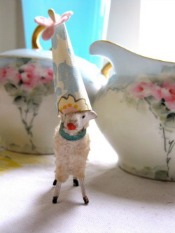
Oh Claudia! By the end of the day, my face would hurt from all the smiling and I would need a hot pack for my neck from constantly looking upwards! Wow, it is gorgeous! That narrow house with those light shutters and rockers on the porch…sigh!
I know! It’s so beautiful. It’s sort of the same way I felt when I was taking pictures of the houses in Chautauqua, which are equally beautiful.
they are all lovely, but i’ll go for # 1324 and leave you the others. :)
i heard someone say that a person either loves or hates new orleans. well, for me, there is so much to love about that place! glad you’ve found that, too. hope you and don can return there someday when neither of you is on a job so you can enjoy more of new orleans’ charms together!
kathy in iowa
I can’t imagine not loving it. There are times when the craziness gets to be a bit much, but nonetheless, I really love this city.
I’ve so enjoyed your posts from New Orleans. Makes me want to take a trip home and visit. Such an amazing and beautiful city. I can remember walking through the garden district as a child and teenager and dreaming of living there one day.
Now as an adult the reality has sat in and I know that more than likely won’t be in my budget in this lifetime! But that’s okay, I’ll visit and enjoy the beauty of these homes.
Have a great day Claudia.
No, the prices are really high! But it’s always fun to dream.
I was looking forward to my “NOLA trip” this morning and it did not disappoint! Thanks a bunch and yes, do price a few for us, please. (I wonder if that rooftop wild boar is a Hallowe’en thing or just a quirky everyday ornamentation?)
Many are over a million dollars and even the smallest are at least 400,000.
I think it’s an everyday ornamentation. It’s made out of copper.
Claudia, Those homes are sop pretty. I too love the blue ceiling and corbel details. Every house had a beautiful character. Blessings, xoxo, Susie
They are indeed beautiful, Susie.
I want the “oh my heavens house”!! I’m convinced I could live there. And yes….we neeed real estate prices. I was checking out your instagram photos…oh my…that tile work! Have another great day! ;)
Several hundred thousand dollars at the very least, Donnamae. Unless you’re buying a condo in a more modern building. It’s very pricey!
The Garden District is a must see when visiting NO. So glad you had a lovely day to wander and wonder at the beauty of these vintage homes. Great photos!
Thanks, Linda. It’s very pretty there and it seems quite peaceful, as well.
I know you had a lovely walk with a surprise awaiting you every where your head turns, Claudia. I can’t help but think that NO painters must be pretty busy people! Have you seen any of the areas that are still recovering from Katrina? I’m glad the city is attracting its share of visitors, but hope that the rebuilding efforts have not stalled in the wake of disasters in other places. Recovery takes such a long long time.
No. I haven’t had the time to search out those areas. It looks to me as if it’s doing very well in terms of recovery.
Have been enjoying your photo tours of NOLA so much, Claudia. I love that Creole Pink and Charleston Green color combo and you reminded me of haint blue; I’d forgotten.
Could the small, narrow homes possibly be what are called shotgun houses? I’d read of them some years ago. Did you mention it and I missed it?
Wiki below, excerpted/edited heavily by me (theories abound):
A shotgun house is a narrow rectangular domestic residence, usually no more than about 12 feet wide, with rooms arranged one behind the other and doors at each end of the house. It was the most popular style of house in the Southern United States from the end of the American Civil War (1861–65) through the 1920s. A longstanding theory is that the style can be traced from Africa to Haitian influences on house design in New Orleans. Though initially as popular with the middle class as with the poor, the shotgun house became a symbol of poverty in the mid-20th century. As of October, 2017, it is fair to say that some of these houses were being bulldozed as part of urban renewal, while others were being saved for historic preservation. Others were saved and renovated in areas that undergo gentrification.
Several variations of shotgun houses allow for additional features and space, and many have been updated to the needs of later generations of owners. The oldest shotgun houses were built without indoor plumbing, but this was often added later, often on the back of the house (sometimes crudely). ‘Double-barrel’ or ‘double’ shotgun houses consist of two houses sharing a central wall, allowing more houses to be fit into an area. ‘Camelback’ shotgun houses include a second floor at the rear of the house. In some cases the entire floor plan is changed during remodeling to create hallways.
‘Shotgun’ is a reference to the idea that if all the doors are opened, a shotgun blast fired into the house from the front doorway will fly cleanly to the other end and out at the back…but (it’s also been said that) the origin of the building style and the name itself may trace back to Haiti and Africa during the 18th century and earlier…the name (maybe originating) from an area term ‘to-gun’, which means ‘place of assembly’…probably used in New Orleans by Afro-Haitian slaves (and) misunderstood and reinterpreted as ‘shotgun’.
In 1803 there were 1,355 free blacks in the city. By 1810 blacks outnumbered whites 10,500 to 4,500. This caused a housing boom. As many of both the builders and inhabitants were Africans by way of Haiti…it is only natural they modeled the new homes after ones they left behind in their homeland. A simpler theory is that they are the typical one-room-deep floor plan popular in the rural south, rotated to accommodate narrow city lots. Such houses were built throughout hot urban areas in the South, since the style’s length allowed for excellent airflow, while its narrow frontage increased the number of lots that could be fitted along a street.
Shotgun houses were most popular before widespread ownership of the automobile allowed people to live farther from businesses and other destinations. Building lots were small, 30 feet wide at most. An influx of people to cities, both from rural areas in America and from foreign countries, all looking to fill emerging manufacturing jobs, created the high demand for housing in cities. Shotgun houses were built to fulfill the same need as rowhouses in Northeastern cities. Several were often built at a time by a single builder, contributing to their similar appearance.
Shotgun houses have many standard features in common. The house is almost always close to the street, sometimes with a very short front yard. In some cases, the house has no setback and is actually flush with the sidewalk. The original steps were wood, but were often replaced with permanent concrete steps.
A sign of its New Orleans heritage, the house is usually raised two to three feet off the ground. There is a single door and window in the front of the house, and often a side door leading into the back room, which is slightly wider than the rest of the house. The front door and window often were originally covered by decorative shutters. Typically, shotgun houses have a wood-frame structure and wood siding, although some examples exist in brick and even stone. Many shotguns, especially older or less expensive ones, have flat roofs that end at the front wall of the house. In houses built after 1880, the roof overhangs the front wall, and there is usually a gable above the overhang. The overhang is supported by decorative wooden brackets, and sometimes contains cast iron ventilators.
The rooms are well-sized, and have relatively high ceilings for cooling purposes, as when warm air can rise higher, the lower part of a room tends to be cooler. The lack of hallways allows for efficient cross-ventilation in every room.
Shotgun houses have even been praised as quality and cost-effective cultural assets that promote a distinctive urban life. There are many large neighborhoods in older American cities of the south which still contain a high concentration of shotgun houses today. The shotgun house plays a large role in the folklore and culture of the south. Superstition holds that ghosts and spirits are attracted to shotgun houses because they may pass straight through them, and that some houses were built with doors intentionally misaligned to deter these spirits. They also often serve as a convenient symbol of life in the south.
Elvis Presley was born in a shotgun house. The John Mellencamp song “Pink Houses” was inspired when he was driving along an overpass on the way home to Bloomington, Indiana from the Indianapolis airport. There was an old black man sitting outside his little pink shotgun house with his cat in his arms, completely unperturbed by the traffic speeding along the highway in his front yard. “He waved, and I waved back,” Mellencamp said in an interview with Rolling Stone.
Yes, I talked about shotgun houses earlier in the week. And creole cottages, which are also everywhere in the French Quarter. They are incredibly charming.
2905 is the one I sort of did a tiny gasp when I saw! But they are all beautiful. Prices will be fun to hear. Sounds like you have had a fabulous trip. Does Don come home for a bit now, or does he go directly to the next city?
Safe travels on your way home tomorrow.
Oh no. Don won’t be home until the first week of December. He leaves on Sunday for Houston and next week they perform there. Then they travel to Chicago for four weeks.
I felt like I was touring the Garden District streets myself in today’s post. Just lovely. Will be very interested to find out prices too. I actually subscribe to a real estate service & get listings daily here, although not for here in the Finger Lakes where I live. I get listings from the Houlihan & Lawrence firm for the Hudson Valley region. I signed up for Westchester, Dutchess, Putnam, Orange & Ulster counties – and although most of the houses there are wildly-beyond anything I could afford, I just LOVE looking at them. I remember one of the first I was sent was an equestrian training estate & home with tons of acreage, for a mere $28 million! I certainly have learned how the 1% lives. I actually think that it’s STILL for sale, by the way. Lots of very nice “regular” homes too. I just love looking at them, especially the older ones. I get decorating ideas from some – and dream about renovating others. One of the very best things the Internet has brought – to my way of thinking at least. PS – I hope you’ll still be in NO for Halloween – I can’t wait to see how the natives celebrate there. Peace… 🎃
#Resist
No, I leave tomorrow. And Don leaves Sunday for Houston. Neither of us will be here for Halloween.
An interesting note, the reason for the ceilings and eaves of Victorian homes being painted sky blue is that it mimics the sky and deters birds from building nests! Speaking of which, we close on our Victorian tomorrow! I see a Claudia visit in the offing for photo ops!
Yes, I’ve referred to that before – the color is Haint Blue.
So excited for you! When do you move?
What history those glorious old houses have seen! Looks like if you’re into porches, NO is the place to live. Simply beautiful pix, Claudia.
They love their verandas and porches here. They’re so beautiful!
What beautiful homes! I always like to check out real estate prices in the places we visit! I am sure enjoying your visit! Great pictures!
I am having a great time – it’s back home to NY tomorrow!
I first heard about shotgun houses on an episode of This Old House that took place in New Orleans after Katrina…they were there to renovate one…they explained all about them and it was very interesting….I think I would love to love in one!…This has been an extraordinary trip Claudia thank you so much!…Tell Don we will see him in Chicago!
I will! Thanks, Nancy!
I am in the process of redoing my back porch (before winter sets in) and the first thing: haint blue ceiling. I think everybody has a different take on it…According to my Irish Philadelphia family, the blue ceilings kept away the bad spirits and brought good luck!
Your pictures are divine. What a good time you had.
I keep thinking we need to paint our porch ceiling haint blue as well! Thanks, Elle.